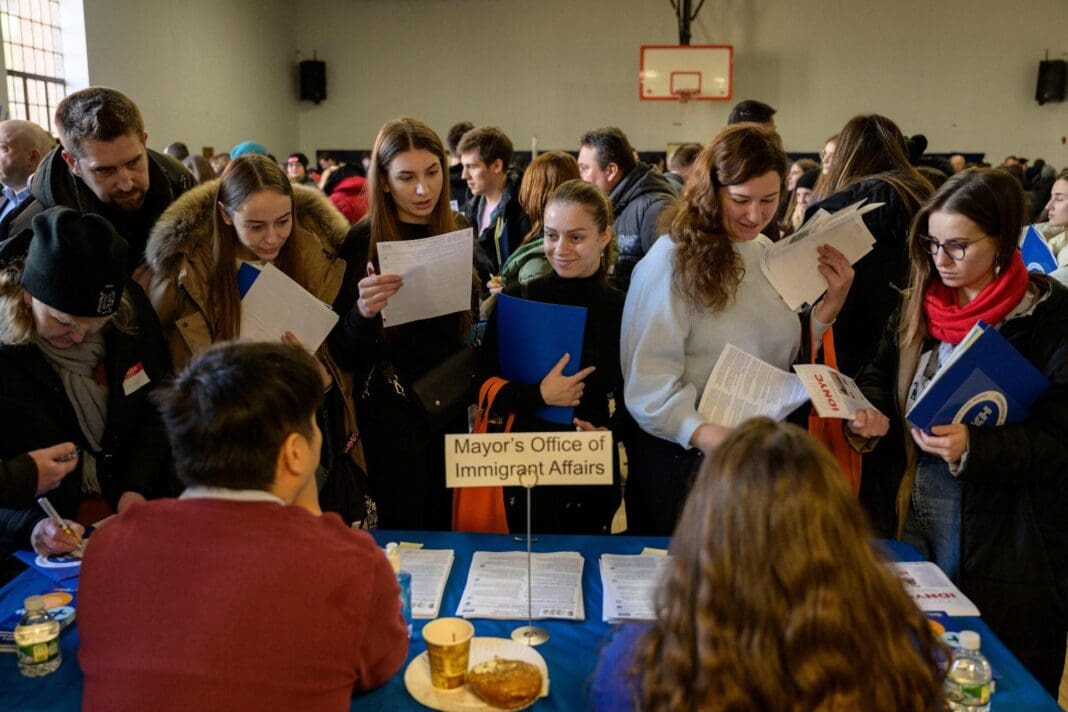In the most significant change to U.S. refugee resettlement in 40 years, the federal government is turning to the public and the private sector to help settle people who have fled their home countries because of war, persecution and ongoing armed conflicts.
Today, there are more than 110 million people who have been forced from their homes and countries, the highest number on record. But despite this increased need for immigrants and refugees to find homes, they are often blocked from entering many countries because of security concerns, rising xenophobia and nativism.
Since 1980, the U.S. has had one of the largest resettlement programs in the world. The federal government and 10 nonprofit organizations have worked together to give immigrants and refugees the services they need to resettle. But recent controversies as well as cutbacks under the Trump administration have led government officials and their partners to determine that a new, complementary approach, one that pulls in help from communities across the country, is necessary.
As resettlement researchers, we have conducted research on recent changes to the U.S. program. Our research indicates that, while not a total solution, new community sponsorship programs – in which average citizens, acting as refugee sponsors, help refugees settle into the community – may address current flaws, such as lack of funding, in the traditional resettlement program.
The Biden administration has introduced several initiatives to work alongside the longstanding resettlement program that allow these citizen sponsors to directly resettle refugees in their communities by raising private funds for their living expenses and connecting refugees with housing, transportation and employment. In the newly announced Welcome Corps program, for example, sponsors have to raise $2,375 for each refugee and commit three months of financial support, as well as up to 12 months of social support. Community sponsorship projects, similar to Welcome Corps, have been piloted in more than 40 states and 90 communities.
Forms of community sponsorship have been successful in the past. For example, throughout the 1960s and 1970s, the U.S. welcomed more than 1 million refugees from Southeast Asia through community sponsorship.
But by the 1980s, an economic recession and shifts in public attitudes toward refugees reduced the popularity of community sponsorship. Some sponsors indicated a preference for certain racial or religious groups, while others faced resentment when certain refugees were perceived to be less appreciative than expected.
Around the same time, Congress passed the 1980 Refugee Act to standardize resettlement and shift from the community sponsorship model to the professional resettlement agencies that are still active. And a new government-imposed focus on economic self-sufficiency required refugees to find employment and move off government benefits as soon as possible, forcing them into low-wage, entry-level jobs, with little support to navigate the job market or society.
The traditional resettlement program is not without flaws. Over time, federal funding for resettlement services has dwindled. Some scholars have criticized the program’s focus on self-sufficiency as inadequate to support refugees’ initial and long-term needs. And cities and states new to the program have been hobbled by their inexperience in resettling refugees.
People who would like to see more refugees settled in the U.S. tout new community sponsorship programs as a solution to problems with the existing program. In the new Welcome Corps program, for example, sponsor groups raise private funds to provide services, reducing the need for federal funding. Research indicates that sponsor groups may be able help refugees with integration. But arrangements in which average citizens, not organizations, direct refugees’ settlement in the country can create unequal relationships between the so-called sponsors and refugees. In our view, sponsorship outsources federal responsibilities for resettlement to private citizens, which sidesteps the nation’s humanitarian commitments.
We have conducted interviews and surveys with resettled refugees, community sponsors and resettlement practitioners, including agency staff and local officials, as part of larger and ongoing studies of resettlement in the U.S.
What we have found, so far, is that there is a great deal of confusion among resettlement workers and new sponsors – about the different kinds of refugees, how they come to the U.S., what rights they have to work, what their legal status might be, and who they can turn to when they need assistance. Similarly, we found high levels of confusion among sponsors regarding who they can rely on to solve problems and get help.
The federal government is trying to give community sponsor groups specific guidance about where to get the help they may need. But our research shows that new sponsors often turn to the traditional resettlement agencies with their questions, which creates more work for resettlement agencies that already have heavy workloads. Community sponsorship programs were intended to function alongside the traditional resettlement program – not to add to the workload of resettlement agencies.
Our preliminary research – which one of us presented to national resettlement organizations and governmental representatives in August 2023 – suggests that community sponsorship requires a significant time commitment, ranging from three to 12 months, and many new sponsors need additional guidance to navigate the period successfully. These hurdles may prevent citizens from getting involved in the program.
Without a reliable network of people willing to help resettle refugees and a steady way to pull in more of these volunteers, the future of community sponsorship programs may be uncertain.
This article is republished from The Conversation, an independent nonprofit news site dedicated to sharing ideas from academic experts. Like this article? Subscribe to our weekly newsletter.
Read more: Refugees are living longer in exile than ever before, with complex consequences for them and their host communities Some refugees stay in temporary status indefinitely – how they still manage to create homes and communities
Emily Frazier receives funding from the Russell Sage Foundation and the Social Science Research Council.
Pablo Bose receives funding from the National Science Foundation. He is affiliated with the American Association of Geographers where he serves as a National Councillor.








